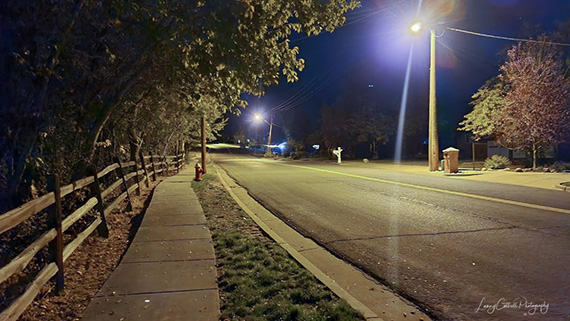There’s an old expression that a photographer’s first 10,000 photos are their worst. That means if you want to become a good photographer, you have to take at least 10,000 photos—and make sure you are practicing and learning how to take pictures, not just snapshots.

Photo by Pixabay on Pexels
If you go out for a walk in your neighborhood, do you always find photos opportunities? When I go for a walk, I am looking for inspiration everywhere. I don’t think my family likes walking with me, because I am always stopping to take a picture of something.
In order to always find a photo to take, I recommend following a few basic rules.
Know the rules to composition

You have to see the leading lines in a photo. (Photo by Lanny Cottrell)
Memorize the rules of composition. Every time I go out for a walk, I see the rules of composition right in front of me. Can you see the leading lines? How about the rule of thirds? Can you take a photo and put it in the “thirds” format? Do you know the rule of space? Rule of odds? Do you know where to put your horizon line? Finally, can you detect patterns?
Let’s go through these rules one by one, with examples. If you want to master this process of “seeing a photo,” it will be because you have memorized composition rules, and are able to recognize them when you see them.
Leading lines

See the “leading lines” in this photo? There are several leading lines in this. (Photo by Lanny Cottrell)
In this night photo above, you can see the lines from the fence, the sidewalk, the road and the lane divider. This one is easy to see. Look for those lines. One thing in general with this rule:you don’t want the lines to be straight down the middle, or go from side to side. They generally need to go diagonally.

These leading lines go right down the middle. (Photo by Lanny Cottrell)
Can leading lines go down the middle, or from side to side? Hey—some rules are meant to be broken. As in the photo above, sometimes you can’t help but snap a clear shot of a very straight highway that stretches as far as the eye can see. If it tells a good story, take it.
Rule of thirds

The idea of “put the subject in the third part of your frame” is spot on. (Photo by Lanny Cottrell)
In the above example, I could have put the sign and seagull right in the middle, but this looks so much better. Once you start taking photos, and you notice your subject is right in the middle, you’ll recognize that it doesn’t look right.
Rule of space

Photo by Nuno Obey
If this boat were moving, you would need to give it space to move into. So leave some space in front of the boat. If this boat was placed more to the left, it would look awkward. This is just a function of the brain.

Photo by Pixabay
This photo of the cat is another great example of giving “space”. The cat is looking into an area that might have something. The photo would look awkward if the cat were on the other side of the photo, based on which direction it’s looking. Is this photo also a “rule of thirds”? Yes, I believe so, as long as you put it in the correct quadrant of the photo.
Rule of odds

Rule of “odds”. (Photo by Lanny Cottrell)
This particular rule is sometimes impossible to get, but the idea is that put your subjects in odd numbers: three flowers instead of two, or five buffalo instead of four. As you take pictures of multiple subjects, now you know the rule, so it’s easy to look for that.

Photo by Pixabay
The rule of odds also worked on this one: there are five tiles.

Photo by Pixabay
Here is another great example: in your mind, take out of the giraffes. Then put it back in. See how much nicer three look than two? It’s hard to do all the time, but more people will like your photos if you can manage odd numbers.
Look for patterns

Photo by Lanny Cottrell
Is the above photo one of patterns? Well, yes—a forest is a pattern of trees. They look good like a forest, which falls under the “pattern” rule.

Photo by freestocks.org
To find patterns, you look for a type of photo that most likely takes up the whole picture with a large quantity of the same thing, like above.
Just as a forest is a good pattern, the cluster of fruit slices falls under this same category.

Photo by Lanny Cottrell
Here is one more example of pattern in a photo.
Can you see patterns just walking around your neighborhood?
Horizon placement

Rule of horizon in the right place. (Photo by Lanny Cottrell)
The horizon is the line dividing the ground from the sky. Look at this photo above: even though the photo seems to be about boats in storage, notice that the ground and the sky meet at about the lower third of the photo.

Photo by Lanny Cottrell
This photo features a spectacular sky. In this case, the horizon is in the lower third. If you put the horizon in the top third, you would get more water—but isn’t the sky more spectacular?
Conclusion
You have to memorize these basic rules of composition, or you will never see the photo opportunities around you. Practice walking around your neighborhood and seeing if you can detect any of these rules when looking at the world through your lens. Once you memorize these rules, and take more pictures, you will get closer to reaching those 10,000 photos you need to take before you are good.
About the Author:
Lanny Cottrell has been involved in teaching photography for more than 25 years. He has worked as a manager of a photo store in Utah, and now has started to do the things he loves the most—training photographers to be the best they can be.
Go to full article: Learning How to “See” a Photograph
What are your thoughts on this article? Join the discussion on Facebook
PictureCorrect subscribers can also learn more today with our #1 bestseller: The Photography Tutorial eBook
The post Learning How to “See” a Photograph appeared first on PictureCorrect.
from PictureCorrect https://ift.tt/3tCQ8hm
via IFTTT






0 kommenttia:
Lähetä kommentti